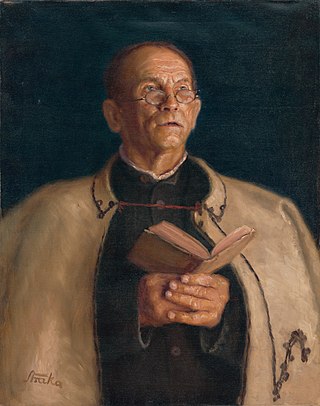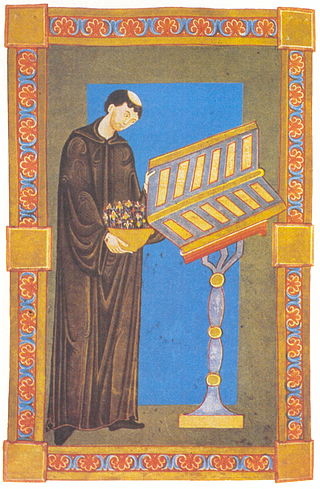Related Research Articles
Communion may refer to:

An antiphon is a short chant in Christian ritual, sung as a refrain. The texts of antiphons are usually taken from the Psalms or Scripture, but may also be freely composed. Their form was favored by St Ambrose and they feature prominently in Ambrosian chant, but they are used widely in Gregorian chant as well. They may be used during Mass, for the Introit, the Offertory or the Communion. They may also be used in the Liturgy of the Hours, typically for Lauds or Vespers.

Gregorian chant is the central tradition of Western plainchant, a form of monophonic, unaccompanied sacred song in Latin of the Roman Catholic Church. Gregorian chant developed mainly in western and central Europe during the 9th and 10th centuries, with later additions and redactions. Although popular legend credits Pope Gregory I with inventing Gregorian chant, scholars believe that it arose from a later Carolingian synthesis of the Old Roman chant and Gallican chant.

Acta Sanctorum is an encyclopedic text in 68 folio volumes of documents examining the lives of Christian saints, in essence a critical hagiography, organised by the saints' feast days. The project was conceived and begun by the Jesuit Heribert Rosweyde. After his death in 1629, the Jesuit scholar Jean Bolland continued the work, which was gradually finished over the centuries by the Bollandists, who continue to edit and publish the Acta Sanctorum.

The communion of saints, when referred to persons, is the spiritual union of the members of the Christian Church, living and the dead, but excluding the damned. They are all part of a single "mystical body", with Christ as the head, in which each member contributes to the good of all and shares in the welfare of all.

Church music is Christian music written for performance in church, or any musical setting of ecclesiastical liturgy, or music set to words expressing propositions of a sacred nature, such as a hymn.

An antiphonary or antiphonal is one of the liturgical books intended for use in choro, and originally characterized, as its name implies, by the assignment to it principally of the antiphons used in various parts of the Latin liturgical rites.

The Scala Sancta are a set of 28 white marble steps located in an edifice on extraterritorial property of the Holy See in Rome, Italy proximate to the Archbasilica of Saint John in Laterano. Officially, the edifice is titled the Pontifical Sanctuary of the Holy Stairs, and incorporates part of the old Papal Lateran Palace. Replica stairs flank the original staircase, which may only be climbed on one's knees. The Holy Stairs lead to the Church of Saint Lawrence in Palatio ad Sancta Sanctorum or simply the "Sancta Sanctorum", which was the personal chapel of the early Popes.
The Communion is a refrain sung with psalm recitation during the distribution of the Eucharist in the Divine Liturgy or Mass. As chant it was connected with the ritual act of Christian communion.
The Postcommunion, in Catholic liturgy, is the text said or sung on a reciting tone following the Communion of the Mass.

Beneventan chant is a liturgical plainchant repertory of the Roman Catholic Church, used primarily in the orbit of the southern Italian ecclesiastical centers of Benevento and Monte Cassino distinct from Gregorian chant and related to Ambrosian chant. It was officially supplanted by the Gregorian chant of the Roman rite in the 11th century, although a few Beneventan chants of local interest remained in use.

The Mass is the central liturgical service of the Eucharist in the Catholic Church, in which bread and wine are consecrated and become the body and blood of Christ. As defined by the Church at the Council of Trent, in the Mass "the same Christ who offered himself once in a bloody manner on the altar of the cross, is present and offered in an unbloody manner". The Church describes the Mass as the "source and summit of the Christian life", and teaches that the Mass is a sacrifice, in which the sacramental bread and wine, through consecration by an ordained priest, become the sacrificial body, blood, soul, and divinity of Christ as the sacrifice on Calvary made truly present once again on the altar. The Catholic Church permits only baptised members in the state of grace to receive Christ in the Eucharist.

In Christianity, the cantor, female chantress, sometimes called the precentor or the protopsaltes, is the chief singer, and usually instructor, employed at a church, with responsibilities for the choir and the preparation of the Mass or worship service. The term is also used for a similar task in Reform Judaism and in Ancient Egypt.

Saint Wandregisel was a Frankish courtier, monk, and abbot.

Thiofrid was the Benedictine abbot of Echternach Abbey, and writer of works in several different areas. He is one of the few medieval writers to discuss the cult of relics, in his Flores epytaphii sanctorum.
Gerald Moultrie was a Victorian public schoolmaster and Anglican hymnographer.
Sanctorum may refer to:
In Lutheranism, the Eucharist refers to the liturgical commemoration of the Last Supper. Lutherans believe in the real presence of Christ in the Eucharist, affirming the doctrine of sacramental union, "in which the body and blood of Christ are truly and substantially present, offered, and received with the bread and wine."

In many Western Christian traditions, Midnight Mass is the first liturgy of Christmastide that is celebrated on the night of Christmas Eve, traditionally beginning at midnight when Christmas Eve gives way to Christmas Day. This popular Christmas custom is a jubilant celebration of the mass or service of worship in honour of the Nativity of Jesus; even many of those Christian denominations that do not regularly employ the word mass uniquely use the term "Midnight Mass" for their Christmas Eve liturgy as it includes the celebration of Holy Communion.

Chant Noël: Chants for the Holiday Season is a compilation album of plainsong sung in Latin by the Benedictine monks of Santo Domingo De Silos under the direction of Francisco Lara. It was released in November 1994 by Angel Records, following the success of Chant which had been released earlier the same year. As well as a number of items sung at Christmas, the album features Ubi Caritas, which is associated with Easter.
References
- ↑ Shrock, Dennis (2022). Choral Repertoire. Oxford University Press. p. 484. ISBN 978-0-19-762240-7.